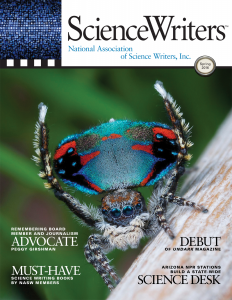Arizona’s public radio stations are trying something new. Recently, all four NPR member stations began collaborating on locally produced content. The partnership involves editors and reporters in Flagstaff, Phoenix, Tucson and Yuma. Our goal is to share untold stories about science in our communities.
Despite strong public interest in science, health, and technology, media coverage of these beats has been shrinking: Arizona’s local newspapers have cut science sections and staff, and other media outlets have not picked up the slack. That’s why Mark Moran, associate general manager for news at KJZZ in Phoenix, sought Corporation for Public Broadcasting (CPB) funding for a statewide science desk.
“From leading research on military fighter jets in Yuma, to cancer research in Tucson, and from Alzheimer’s research at the Translational Genomics Research Institute in Phoenix, to dark skies and astronomical work in Flagstaff, scientists routinely unearth stories of importance that impact listeners’ lives at the most basic level,” Moran wrote in his CPB grant request. “Arizona needs a statewide Science Tech Desk to bring stories rather than sound bytes and press releases to our audiences.”
The CPB grant partially funds the Arizona Science Desk for two years, and each station picks up the rest of the tab for their respective reporter. The desk came online in summer 2015.
Here’s what the team has attempted and learned in the initial months of this collective experiment:
Andrew Bernier was the first reporter hired for the desk. He reports in Phoenix, the largest metropolitan area in the state and home to Arizona State University.
“The real challenge came from taking on an entire market that had nearly nothing on reputable local science coverage,” said Bernier. “As a former science teacher, I was curious how I could capture and experiment with sound to best convey the complexity of research and innovation happening in the Phoenix valley to complement quotes and detailed explanations, all in a four-minute feature piece.“I joined KAWC in Yuma, near the U.S.-Mexico border. Yuma is a small city, tucked into the Sonoran Desert on the Colorado River. Water, energy, ecology and agriculture are all big science-related topics here.
“Because there is no major research institution in the area, I do quite a bit of legwork to establish good science contacts in the community. This also forces me to be creative: I found a rare bird with the help of the local Audubon Society chapter and have driven miles into the desert to see engineers test a drill they want to use one day on Mars.”
Sara Hammond is our reporter at KUAZ in Tucson. She works on the campus of her alma mater, the University of Arizona.
“While most of the research dollars coming into southern Arizona support projects at the university, there are many firms, from large multinationals to small startups, doing important scientific research,” said Hammond. “I try to highlight those unseen projects in my work.”
Melissa Sevigny of KNAU reports on science developments in Flagstaff. She’s covered the challenges of raising grass-fed beef, the quirks of Africanized bees in cool climates, and the controversy over uranium mining near the Grand Canyon.
“I often draw stories from scientific journals, which otherwise might go unreported for local audiences,” she said. “And I look for diverse voices to show how big science interweaves with daily life in northern Arizona. For example, when NASA’s New Horizons mission flew by Pluto in July, I reported on the response of local artists.”
NOTE: Sevigny won’t tell you this, but Minor Planet [15624] Lamberton is named in her honor.
To pull all these perspectives and coverage areas together, we needed a web editor who could create an online home for the science desk:
Sky Schaudt manages the Arizona Science Desk’s home page. Schaudt blends reporter audio with visual and interactive elements. Her digital treatments have ranged from videos and slide shows to interactive charts and quizzes. She also manages our social media accounts.
The biggest challenge so far, according to Schaudt, has been building an online presence in a highly competitive news market.
“My goal over the next year is to continue to grow and deliver Arizona science news to as many readers as possible,” she said.
In Phoenix, editor Kerry Fehr-Snyder coordinates science coverage during weekly team conference calls and reviews scripts.
“We are creating unique science content and angling to be the best place for science reporting in Arizona. In the coming months, we will create an in-depth science series,” she said. “We also recently launched a monthly calendar for Arizona science events, which helps us establish contact with groups making meaningful contributions to science in our state.”
All together, more than 200 science news spots and features have been produced in the early months of the desk. We’re already hearing encouraging feedback from listeners and local organizations about the new science coverage. Right now, our opt-in newsletter reaches nearly 900 readers weekly and counting. This inspires us to continue the experiment, and expand as a resource for our communities.
Visit science.kjzz.org to learn more about the Arizona Science Desk, read team member bios, and see examples of our work. You can also reach us at science@kjzz.org.
(NASW members can read the rest of the Spring 2016 ScienceWriters by logging into the members area.) Free sample issue. How to join NASW.



